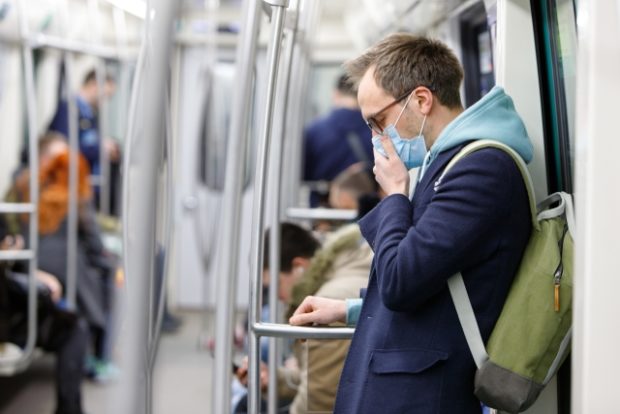The art of coughing and sneezing in the age of COVID-19

Safer ways to cough and sneeze during the COVID-19 pandemic. Image: Shutterstock/DimaBerlin via AFP Relaxnews.
Since the beginning of the COVID-19 pandemic, coughing and sneezing in public can feel similar to taking your kid to the hairdressers when they’ve got nits. You’re that person. People look, they glare, they judge, making you feel like some kind of pariah. While it is impossible to stop yourself from coughing or sneezing, there are ways of doing so that can limit the spread of COVID-19, as well as as other viruses. Here’s how to go about coughing and sneezing in the age of COVID-19.
Achoo! At best, that sneeze will have done nothing more than startle the person sitting opposite you, but at worst, tiny droplets will have been carried through the air, potentially landing on your neighbor, contributing to the spread of the coronavirus disease.
Learning how to respond to this reflex action — which, like a cough, could be caused by a common cold, an allergy or an irritation — could play a role in limiting the spread of the virus. And that can only be a good thing as fall sees the first of this winter’s viruses start to do the rounds.
Go for your elbow
The advice endlessly given to children to remind them of good hygiene practices is usually the best advice for adults too — even if we tend to forget that.
“Wash your hands” and “sneeze or cough into your elbow” are good habits to get into, no matter your age. But is it possible to sneeze or cough into your elbow when wearing a mask? Apparently so, as scientists consider this to be the best way of preventing respiratory droplets from spreading through the air.
However, make sure you avoid bringing your elbow into contact with your mask, as much as possible, and try not to touch other people with this part of your body. That may go without saying — especially in the age of physical distancing — but droplets can nevertheless pass through a mask and deposit on your elbow or clothing.
Carry tissues and a spare mask
Another option is to sneeze or cough into a disposable tissue. It can be tricky to act fast enough when it is an uncontrollable reflex, but if you have the time, do not hesitate to get out a tissue to help stop the spread of respiratory droplets.
That is what Maria Sundaram, a postdoctoral researcher and epidemiologist at ICES Ontario, advised Eliza Goren of the Washington Post. Indeed, the scientist recommended covering your mouth and nose with the tissue to prevent particles from escaping, then throwing away the tissue immediately after use and cleaning your hands with soap and water or with hand sanitizer.
While summer was less conducive to colds, throat infections and other winter ailments, now is the time to start carrying a spare mask at all times. That way, you can stay comfortable by changing it as and when you like if you are coughing or sneezing a lot, as a mask can become uncomfortable or dirty. In any case, a spare mask is a must-have for mishaps like a snapped elastic or wet weather, which renders a mask unusable in just a few minutes.
To prevent droplets becoming airborne and spreading indoors — in the office, at home or in other closed spaces — the best solution is to go outside to cough or sneeze. Physical distancing should still be maintained, however, and you should keep your mask on as much as possible. CC
RELATED STORIES:
Dos and don’ts: Social media etiquette during pandemic
To do list in entering your home after running an errand during this COVID-19 pandemic